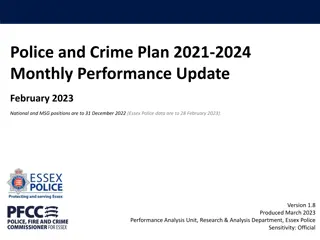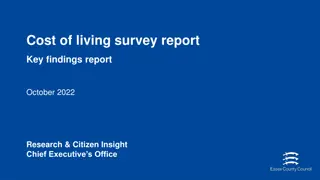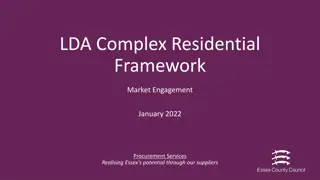
Dynamic Microsimulation Modelling: NIESR Parameterisation Study
Delve into the challenge of model parameterisation for dynamic microsimulation at the National Institute. Explore the approach, core characteristics, and objective function of the NIESR model. Uncover the focus on medium to long-term planning for savings and retirement, along with the adopted parameterisation method involving observable and unobservable parameters. Gain insights into the comparability of pseudo-panel data and the implications for economic decision-making.
Download Presentation

Please find below an Image/Link to download the presentation.
The content on the website is provided AS IS for your information and personal use only. It may not be sold, licensed, or shared on other websites without obtaining consent from the author. If you encounter any issues during the download, it is possible that the publisher has removed the file from their server.
You are allowed to download the files provided on this website for personal or commercial use, subject to the condition that they are used lawfully. All files are the property of their respective owners.
The content on the website is provided AS IS for your information and personal use only. It may not be sold, licensed, or shared on other websites without obtaining consent from the author.
E N D
Presentation Transcript
PSEUDO PANEL DATA FOR MODEL PARAMETERISATION Applications for dynamic microsimulation modelling at the National Institute Justin van de Ven 29/10/2019 www.niesr.ac.uk - www.unimelb.edu.au 1
OUTLINE Microsimulation at the NIESR Model parameterisation The challenge Implemented approach Motivation Comparability of pseudo panel data through time Income Consumption Savings rates Summary www.niesr.ac.uk - www.unimelb.edu.au 2
MICROSIMULATION AT THE NIESR A Structural Dynamic Microsimulation model to project the two principal economic margins of decision making: labour / leisure consumption / savings Model designed to simulate panel data for each individual in a reference population described by survey data Core set of simulated characteristics: - age - relationship status - wage potential - pension wealth - retirement - migration status - children - nonpension wealth - time of death www.niesr.ac.uk - www.unimelb.edu.au 3
MICROSIMULATION AT THE NIESR Objective function: ( , , , t i t i t V w h 1 1 1/ T ( ) ) 1 1/ j t = max i t c , E u c i j l j t t , , , t i j , i t l j t = , , 1 ( ) ( ) 1 1/ 1 1/ 1 1/ = + max i t c , , u c l E V w h + + + , , 1, 1 , 1 , 1 i t i t t t t i t i t , i t l , , 1 ) ( ) ( 1 1/ = + 1/ 1 1/ , i t l , u c l c 1 1/ , , , i t i t i t Uncertainty taken into account Based on Dynamic Programming methods Van de Ven, J. (2017), Economic Modelling, 63, pp. 161-74. www.niesr.ac.uk - www.unimelb.edu.au 4
CHALLENGE OF MODEL PARAMETERISATION The model is designed to explore aspects of medium to long- term planning savings, and retirement. The challenge is to design a coherent strategy to parameterise this model The focus of our model on medium term planning suggests the use of extended time-series data for parameterisation. This research avenue has not been fully pursued due to: persistent questions concerning data comparability difficulties associated with capturing the evolving policy context, including measures of uncertainty Van de Ven, J. (2017), International Journal of Microsimulation, 10, pp. 135-166 www.niesr.ac.uk - www.unimelb.edu.au 5
PARAMETERISATION METHOD ADOPTED Parameters partitioned into two sets: observable marital rates, divorce rates, fertility rates, mortality rates unobservable preference parameters, dynamics of wage potential (Heckman selection) Observable model parameters based on time-series survey data and official projections Preference parameters adjusted to match simulated consumption and employment behaviour to moments described by data for a single population cross-section Wage parameters adjusted to reflect moments described by pseudo panel data www.niesr.ac.uk - www.unimelb.edu.au 6
MOTIVATION FOR ADOPTED APPROACH Reflect official assumptions for margins orthogonal to principal focus of interest mortality, relationship status, fertility validity of these statistics ignored (e.g. persistent errors in mortality rates) Behaviour central to the model is parameterised on data observed at a single point in time a single policy context ignore dynamics of measurement error in reported data ignore changing variable definitions through time assumptions required concerning inter-cohort variation Capture wage growth by age and birth cohort as described by survey data sources a primary margin for the development of inter-cohort (economic) inequality assumptions required concerning stability of measures through time www.niesr.ac.uk - www.unimelb.edu.au 7
PSEUDO PANEL DATA UK has a relatively long time-series of comparable publicly available microdata The FES, EFS, and LCF report detailed, broadly comparable measures of household demographics, employment, income, and consumption at annual intervals between 1968 and 2016 (inclusive) Results from our data reconciliation analysis reported in: National Institute Economic Review, 2011 (R44-57) Van de Ven, J. and H rault, N. (2019), The evolution of tax implicit value judgements, redistribution and income inequality in the UK: 1968 to 2015. Summary of most recent findings Top-coding of incomes in survey waves since 2006 problematic for distributional analyses Questions concerning coherence of inter-temporal consumption and income patterns www.niesr.ac.uk - www.unimelb.edu.au 8
INFLUENCE OF TOP-CODING INCOME Equivalised income inequality (Gini) Source: ONS statistics reported in statistical bulletin Effects of Taxes and Benefits on Household Income, 2015/16, Reference Table 11. LCF summary statistics based on authors calculations from LCF microdata. Notes: ONS series reported between 1977 and 2015; LCF series based on data reported at annual intervals between 1968 and 2015/16 inclusive. Household income equivalised using the modified OECD scale. Data weighted by household. Survey weights included from 1996. www.niesr.ac.uk - www.unimelb.edu.au 9
INFLUENCE OF TOP-CODING INCOME Private income quintiles (FRS vs LCF) Source: Authors calculations using microdata from the Living Costs and Food (LCF) survey and Family Resources Survey (FRS), HBAI series. Prices adjusted using the National Accounts final consumption expenditure deflator, Office for National Statistics code YBGA. Notes: Household income equivalised using the modified OECD scale. Data weighted by individual, quintiles evaluated with respect to disposable income. www.niesr.ac.uk - www.unimelb.edu.au 10
INFLUENCE OF TOP-CODING INCOME Disposable income quintiles (FRS vs LCF) Source: Authors calculations using microdata from the Living Costs and Food (LCF) survey and Family Resources Survey (FRS), HBAI series. Prices adjusted using the National Accounts final consumption expenditure deflator, Office for National Statistics code YBGA. Notes: Household income equivalised using the modified OECD scale. Data weighted by individual, quintiles evaluated with respect to disposable income. www.niesr.ac.uk - www.unimelb.edu.au 11
DISPOSABLE INCOME AGGREGATES Disposable income (LCF vs NAs) Source: Survey response rates for LCF derived from Barrett et al. (2015) between 1974 and 2009, and survey technical reports between 2010 and 2015. Response rates for the FRS derived from survey technical reports. Coverage rates for disposable income based on authors calculations. Notes: Coverage rates describe ratios of per-capita measures of disposable income reported by the LCF and FRS to those reported by the National Accounts. National Accounts figures based on historical series for variables QWND (disposable income of households and non-profit institutions) and EBAQ (population aggregate) reported in 2017. LCF disposable income evaluated as described in Appendix B.2 of van de Ven and H rault (2019). 12
DISPOSABLE INCOME AGGREGATES Disposable income (FRS vs NAs) Source: Survey response rates for LCF derived from Barrett et al. (2015) between 1974 and 2009, and survey technical reports between 2010 and 2015. Response rates for the FRS derived from survey technical reports. Coverage rates for disposable income based on authors calculations. Notes: Coverage rates describe ratios of per-capita measures of disposable income reported by the LCF and FRS to those reported by the National Accounts. National Accounts figures based on historical series for variables QWND (disposable income of households and non-profit institutions) and EBAQ (population aggregate) reported in 2017. FRS disposable income evaluated as described in Appendix B.2 of van de Ven and H rault (2019). FRS statistics do not include Northern Ireland prior to 2002. 13
EXPENDITURE AGGREGATES Total household expenditure (LCF vs NAs) Source: Survey response rates for LCF derived from Barrett et al. (2015) between 1974 and 2009, and survey technical reports between 2010 and 2015. Response rates for the FRS derived from survey technical reports. Coverage rates for disposable income based on authors calculations. Notes: Coverage rates describe ratios of per-capita measures of total expenditure reported by the LCF to those reported by the National Accounts. National Accounts figures based on historical series for variables ABPB (Household final consumption expenditure) and EBAQ (population aggregate) reported in 2017. LCF statistics based on measures of aggregate household consumption, reported as p550tp, p508 or p378 (depending on year). 14
AGGREGATE SAVINGS RATES Savings rates out of disposable income (LCF vs NAs) Source: Survey response rates for LCF derived from Barrett et al. (2015) between 1974 and 2009, and survey technical reports between 2010 and 2015. Response rates for the FRS derived from survey technical reports. Coverage rates for disposable income based on authors calculations. Notes: Savings rates represent ratios of aggregate disposable income in excess of consumption to disposable income for each series. www.niesr.ac.uk - www.unimelb.edu.au 15
SUMMARY The UK context is interesting as there exists a relatively long time-series of publicly available micro data for analysis Complemented by breadth of data coverage (e.g. WAS) and convenient terms of access (UK Data Service) The value of this resource has been reduced by (recent) limitations imposed on data access Especially for microsimulation purposes The relatively long time-series raises thorny issues concerning measurement errors, and how those errors vary through time www.niesr.ac.uk - www.unimelb.edu.au 16
AGGREGATE SAVINGS RATES Savings rates out of disposable income (LCF vs NAs) Source: Survey response rates for LCF derived from Barrett et al. (2015) between 1974 and 2009, and survey technical reports between 2010 and 2015. Response rates for the FRS derived from survey technical reports. Coverage rates for disposable income based on authors calculations. Notes: Savings rates represent ratios of aggregate disposable income in excess of consumption to disposable income for each series. www.niesr.ac.uk - www.unimelb.edu.au 17






















